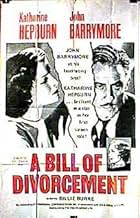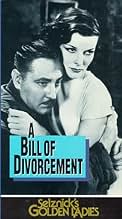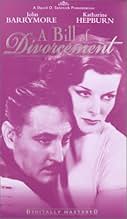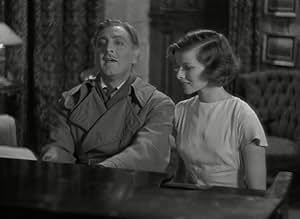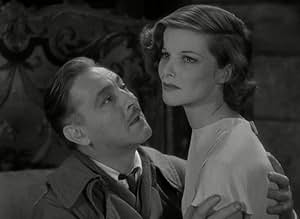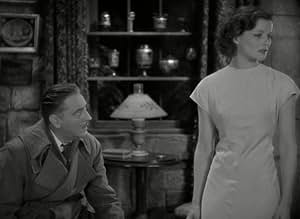IMDb रेटिंग
6.5/10
2 हज़ार
आपकी रेटिंग
अपनी भाषा में प्लॉट जोड़ेंA man, Hilary Fairfield returns home after fifteen years in a mental asylum. However, he finds things are not the way they were when he left.A man, Hilary Fairfield returns home after fifteen years in a mental asylum. However, he finds things are not the way they were when he left.A man, Hilary Fairfield returns home after fifteen years in a mental asylum. However, he finds things are not the way they were when he left.
- निर्देशक
- लेखक
- स्टार
- पुरस्कार
- कुल 5 जीत
Bramwell Fletcher
- Gareth
- (बिना क्रेडिट के)
Dick French
- Party Guest
- (बिना क्रेडिट के)
Julie Haydon
- Party Guest
- (बिना क्रेडिट के)
Dennis O'Keefe
- Party Guest
- (बिना क्रेडिट के)
Mildred Shay
- Party Guest
- (बिना क्रेडिट के)
फ़ीचर्ड समीक्षाएं
A touching, very well done movie. Of course it sounds and looks stagy. Of course the acting seems melodramatic. This is the very early years of talkies, and the material is a play that was already 10 years old in 1932! That gives us some idea of how desperately Hollywood was searching for material with which to make talking pictures. John Barrymore, as other people have said, was on the slippery slope of alcoholism and lived only 10 more years, each more debilitated than the previous one. Yet he never lost his ability and it is a shame he didn't get to be in better films. He could always act! And he knew that his style was dated. He said that his was a 'middle' generation of stage acting, between the florid romantic style of the late 19th and early 20th centuries and the more naturalistic style that followed. Any time he worked with actors and directors he respected: Marie Dressler, Greta Garbo, Hepburn, Billie Burke, Carole Lombard, George Cukor, Howard Hawks --Barrymore turned in an excellent performance.
Though this is the second screen version of Clemence Dane's play A Bill of Divorcement, it's the version that we all remember because it is the film that gave us the director/actress combination of George Cukor and Katharine Hepburn who would then rack up nine more joint ventures in almost fifty years.
Sad to say the play is an old fashioned melodrama that dates pretty badly and it's not really good screen material with the nearly the whole short 70 minute film taking place on only one set. Neither Cukor or Hepburn have quite mastered the screen technique. But the talent and charm were there and it's no wonder Kate had the lengthy career she did.
Though he enters the film when it's nearly a third over, when John Barrymore comes in, he dominates the proceedings. He's a shell shocked World War I veteran returning home after years in an asylum. By that time his wife Billie Burke is in love with another man, Paul Cavanaugh, and is ready to serve Barrymore with divorce papers, hence the title.
Barrymore seems cured, but it doesn't take much to set his fragile psyche out of kilter. What are both Burke and Hepburn to do as it comes out that insanity is prevalent in Barrymore's family tree?
Though the story is very dated, the power of the performances will keep you interested. Quite a lot is packed into a classic film that has an unusually short running time.
Sad to say the play is an old fashioned melodrama that dates pretty badly and it's not really good screen material with the nearly the whole short 70 minute film taking place on only one set. Neither Cukor or Hepburn have quite mastered the screen technique. But the talent and charm were there and it's no wonder Kate had the lengthy career she did.
Though he enters the film when it's nearly a third over, when John Barrymore comes in, he dominates the proceedings. He's a shell shocked World War I veteran returning home after years in an asylum. By that time his wife Billie Burke is in love with another man, Paul Cavanaugh, and is ready to serve Barrymore with divorce papers, hence the title.
Barrymore seems cured, but it doesn't take much to set his fragile psyche out of kilter. What are both Burke and Hepburn to do as it comes out that insanity is prevalent in Barrymore's family tree?
Though the story is very dated, the power of the performances will keep you interested. Quite a lot is packed into a classic film that has an unusually short running time.
This somewhat stagy early talkie is noteworthy for several reasons. First, it is Katharine Hepburn's screen debut, and it is interesting to see that even at 24 she is the prototype of the confident woman that she played in all of her films. Hepburn likely made quite a first impression on audiences with her lean athletic look versus that of typical film heroines of that era that still had that combination china doll and ex-flapper look that was so popular in the 20's. Likewise, just as it is the beginning of Hepburn's career, it is nearing the end of John Barrymore's. By the end of the decade alcoholism and, by some reports, early onset Alzheimer's disease, cause the end of his career. Also, it is interesting to see society's attitudes towards divorce and mental illness in the early 1930's.
Meg Fairfield (Billie Burke) has waited fifteen years while her husband Hilary (John Barrymore) is in a mental institution before finally obtaining a divorce. Shortly before her remarriage, Hilary "comes to himself" and returns home. To complicate matters further, their daughter Sydney (Katharine Hepburn) believes her father has been insane due to shell-shock. However, she soon learns that there is actually insanity in the family and wonders if either she will go insane herself or if her children will. The family doctor also hardly has a good bedside manner in dealing with the situation, saying that "who shall be sacrificed the lame or the whole?" and mentioning that Hilary's child, Sydney, shouldn't even have been born. Startling today, but probably a pretty typical attitude 75 years ago. One of the players puts it best when they mention that people always grieve the dead, but wonder how their reaction would change if the dead were suddenly alive again, which is basically Hilary's situation. Insane he could be mourned for what he once was, recovered he is just in the way. In spite of the usually able direction of George Cukor, this movie comes across as over-the-top melodramatic. However, given its place in Hepburn's film career, it is definitely worth viewing.
Meg Fairfield (Billie Burke) has waited fifteen years while her husband Hilary (John Barrymore) is in a mental institution before finally obtaining a divorce. Shortly before her remarriage, Hilary "comes to himself" and returns home. To complicate matters further, their daughter Sydney (Katharine Hepburn) believes her father has been insane due to shell-shock. However, she soon learns that there is actually insanity in the family and wonders if either she will go insane herself or if her children will. The family doctor also hardly has a good bedside manner in dealing with the situation, saying that "who shall be sacrificed the lame or the whole?" and mentioning that Hilary's child, Sydney, shouldn't even have been born. Startling today, but probably a pretty typical attitude 75 years ago. One of the players puts it best when they mention that people always grieve the dead, but wonder how their reaction would change if the dead were suddenly alive again, which is basically Hilary's situation. Insane he could be mourned for what he once was, recovered he is just in the way. In spite of the usually able direction of George Cukor, this movie comes across as over-the-top melodramatic. However, given its place in Hepburn's film career, it is definitely worth viewing.
At 25, fourth-billed Katharine Hepburn bursts off the screen with her characteristic persona already fully formed in her screen debut as Sydney, the headstrong daughter of WWI veteran Hilary Fairfield, in this antiquated 1932 melodrama. Fifteen years earlier, Hilary was shell-shocked triggering a latent mental instability, which required his wife to institutionalize him. On the day his wife Meg files for divorce, he escapes the asylum in a docile state little realizing how much time has elapsed. In fact, he mistakes Sydney for Meg, as ironically, both Meg and Sydney are soon to be betrothed, The crux of the drama lies in Hilary's insanity and how his sudden appearance forces Meg and Sydney to make life-altering decisions. Directed by George Cukor, the film already shows his innate ease with larger-than-life actors like Hepburn and John Barrymore.
However, the screenplay by Howard Estabrook and Harry Wagstaff Gribble (adapted from an earlier British play by Clemence Dane) is severely dated in its attitude toward familial self-sacrifice, and the film is further hampered by a stilted feeling of staginess throughout. Already in career descent from his alcoholism, Barrymore gives a poignant performance as Hilary giving into heated theatrical fervor in just a couple of key scenes. In what was likely her most substantial role, Billie Burke (later Glinda the Good Witch in "The Wizard of Oz") makes Meg's dilemma palpable, while Elizabeth Patterson (later babysitter Mrs. Trumble on "I Love Lucy") is surprisingly dour as self-righteous Aunt Hester. Hepburn's destiny seems assured from the very first scene, and this was to be the start of her remarkable 47-year professional relationship with Cukor. As of March 2008, the film is not available on DVD.
However, the screenplay by Howard Estabrook and Harry Wagstaff Gribble (adapted from an earlier British play by Clemence Dane) is severely dated in its attitude toward familial self-sacrifice, and the film is further hampered by a stilted feeling of staginess throughout. Already in career descent from his alcoholism, Barrymore gives a poignant performance as Hilary giving into heated theatrical fervor in just a couple of key scenes. In what was likely her most substantial role, Billie Burke (later Glinda the Good Witch in "The Wizard of Oz") makes Meg's dilemma palpable, while Elizabeth Patterson (later babysitter Mrs. Trumble on "I Love Lucy") is surprisingly dour as self-righteous Aunt Hester. Hepburn's destiny seems assured from the very first scene, and this was to be the start of her remarkable 47-year professional relationship with Cukor. As of March 2008, the film is not available on DVD.
It's Christmas in England. World War I veteran John Barrymore (as Hilary Fairfield) has been committed to an asylum for 15 years, due to insanity brought on by "shell shock". The season has resulted in a blessing for Mr. Barrymore, who is on his way home for the holidays, after recovering his sanity. Meanwhile, wife Billie Burke (as Margaret "Meg" Fairfield) has fallen in love again, received a divorce, and is planning to re-marry. Barrymore's return throws the household into turmoil. Daughter Katharine Hepburn (as Sidney Fairfield), also planning to marry, begins to fear starting her own family, after learning Barrymore's madness is hereditary.
It's admittedly not intended as such, and consequently not exceptional; but, George Cukor's "A Bill of Divorcement" should be seen as a filmed stage play. The story is thought-provoking; it mixes madness, marriage, and war with duty, self-sacrifice, and religion. The characterizations are, today, "outdated" in style, substance, and storyline. Still, they are interesting in context. The three lead performances are significant: Barrymore's theatrical skills are clearly evident; his performance is most enjoyable (the war duty scene is a highlight). Additionally, Ms. Burke begins a welcome "second career" in sound films; and Ms. Hepburn begins a welcome "second career" in films. With less to do, steadfast supporting actress Elizabeth Patterson (as Hester Fairfield) definitely holds her own.
****** A Bill of Divorcement (1932) George Cukor ~ John Barrymore, Billie Burke, Katharine Hepburn
It's admittedly not intended as such, and consequently not exceptional; but, George Cukor's "A Bill of Divorcement" should be seen as a filmed stage play. The story is thought-provoking; it mixes madness, marriage, and war with duty, self-sacrifice, and religion. The characterizations are, today, "outdated" in style, substance, and storyline. Still, they are interesting in context. The three lead performances are significant: Barrymore's theatrical skills are clearly evident; his performance is most enjoyable (the war duty scene is a highlight). Additionally, Ms. Burke begins a welcome "second career" in sound films; and Ms. Hepburn begins a welcome "second career" in films. With less to do, steadfast supporting actress Elizabeth Patterson (as Hester Fairfield) definitely holds her own.
****** A Bill of Divorcement (1932) George Cukor ~ John Barrymore, Billie Burke, Katharine Hepburn
क्या आपको पता है
- ट्रिवियाDavid O. Selznick and George Cukor disagreed about casting Katharine Hepburn. Cukor had seen Hepburn's screen test and was impressed by the 24-year-old, but Selznick did not like the way she looked and was afraid she would not be well received by audiences. Cukor cast her anyway (beginning what would be a lifelong professional and personal relationship between the two)
- गूफ़'Katharine Hepburn' is misspelled in the credits as 'Katherine Hepburn'.
- भाव
Hilary Fairfield: Do you know what the dead do in Heaven? They sit on their golden chairs and sicken for home.
- क्रेज़ी क्रेडिटSydney Fairfield is the name of Katharine Hepburn's character in the film, but her name is spelled Sidney in the credits.
- कनेक्शनFeatured in David O. Selznick: 'Your New Producer' (1935)
- साउंडट्रैकSilent Night, Holy Night (1818)
(uncredited)
Music by Franz Xaver Gruber
Lyrics by Joseph Mohr
English lyrics anonymous
Sung by carollers on Christmas Eve
टॉप पसंद
रेटिंग देने के लिए साइन-इन करें और वैयक्तिकृत सुझावों के लिए वॉचलिस्ट करें
- How long is A Bill of Divorcement?Alexa द्वारा संचालित
विवरण
बॉक्स ऑफ़िस
- बजट
- $3,00,000(अनुमानित)
- चलने की अवधि1 घंटा 10 मिनट
- रंग
- पक्ष अनुपात
- 1.37 : 1
इस पेज में योगदान दें
किसी बदलाव का सुझाव दें या अनुपलब्ध कॉन्टेंट जोड़ें


